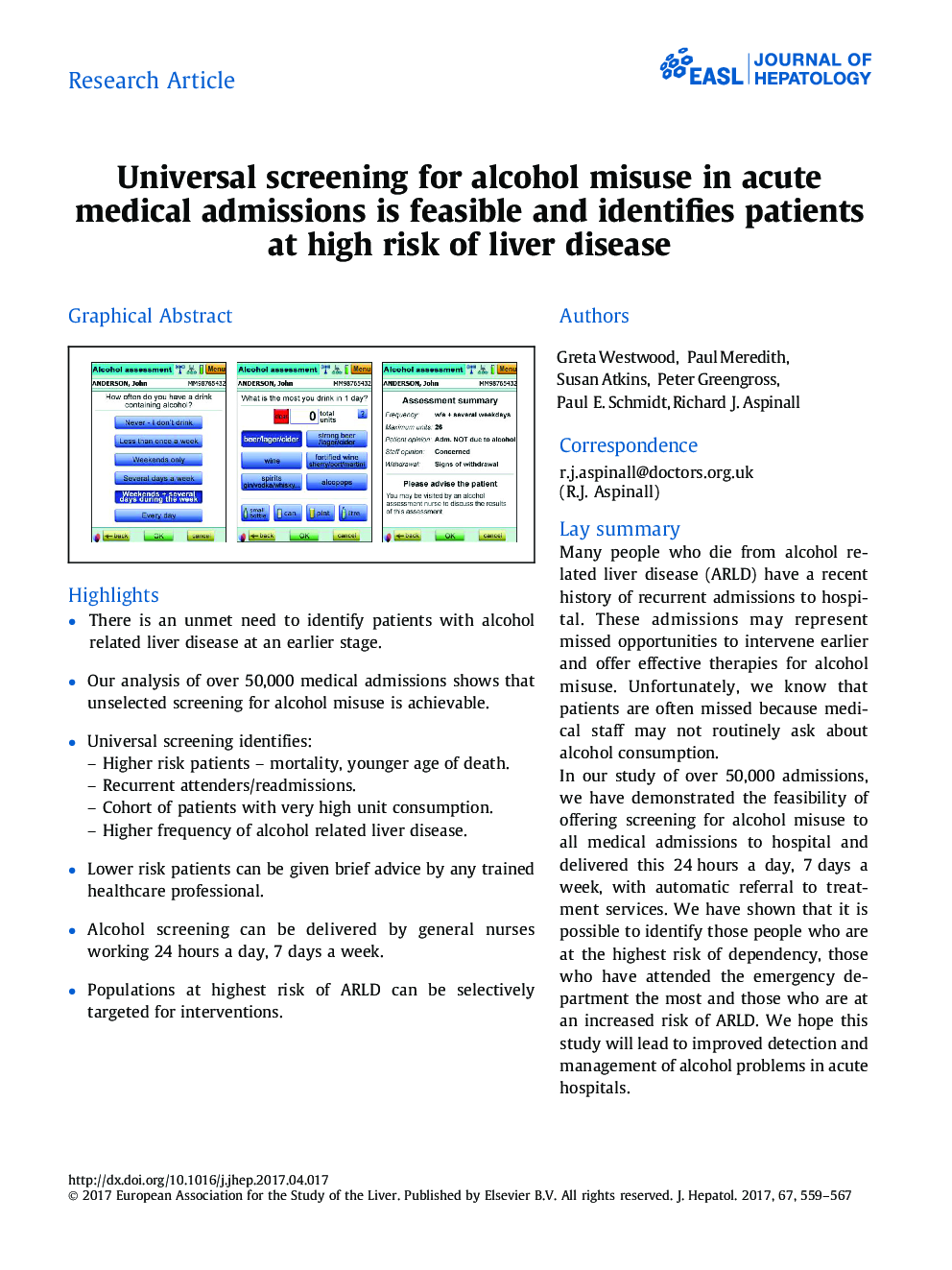| کد مقاله | کد نشریه | سال انتشار | مقاله انگلیسی | نسخه تمام متن |
|---|---|---|---|---|
| 5660401 | 1407489 | 2017 | 10 صفحه PDF | دانلود رایگان |
- There is an unmet need to identify patients with alcohol related liver disease at an earlier stage.
- Our analysis of over 50,000 medical admissions shows that unselected screening for alcohol misuse is achievable.
- Universal screening identifies:-Higher risk patients - mortality, younger age of death.-Recurrent attenders/readmissions.-Cohort of patients with very high unit consumption.-Higher frequency of alcohol related liver disease.
- Lower risk patients can be given brief advice by any trained healthcare professional.
- Alcohol screening can be delivered by general nurses working 24Â hours a day, 7Â days a week.
- Populations at highest risk of ARLD can be selectively targeted for interventions.
Background & AimsMany people who die from alcohol related liver disease (ARLD) have a history of recurrent admissions to hospital, representing potential missed opportunities for intervention. Universal screening for alcohol misuse has been advocated but it is not known if this is achievable or effective at detecting individuals at high risk of ARLD.MethodsWe systematically screened all admissions to the Acute Medical Unit (AMU) of a large acute hospital using an electronic data capture system in real time. Patients at an increasing risk of alcohol harm were referred for either brief intervention (BI) or further assessment by an Alcohol Specialist Nursing Service (ASNS). Additional data were recorded on admission diagnoses, alcohol unit consumption, previous attendances, previous admissions, length of stay and mortality.ResultsBetween July 2011 and March 2014, there were 53,165 admissions and 48,211 (90.68%) completed screening. Of these, 1,122 (2.3%) were classified as “increasing”, and 1,921 (4.0%) as “high” risk of alcohol harm. High risk patients had more hospital admissions in the three previous years (average 4.74) than the low (3.00) and increasing (2.92) risk groups (p <0.001). The high risk patients also had more frequent emergency department (ED) attendances (7.68) than the lower (2.64) and increasing (3.81) groups (p <0.001 for both). A total of 1,396 (72.6%) of the high risk group were seen by the ASNS and 1,135 (81.2%) had an Alcohol Use Disorders Identification Test (AUDIT) score over 20 with 527 (37.8%) recording the maximum value of 40. Compared to the other groups, high risk patients had a distinct profile of admissions with the most common diagnoses being mental health disorders, gastro-intestinal bleeding, poisoning and liver disease.ConclusionsUniversal screening of admissions for alcohol misuse is feasible and identifies a cohort with frequent ED attendances, recurrent admissions and an elevated risk of ARLD. An additional group of patients at an increasing risk of alcohol harm can be identified in a range of common presentations. These patients can be targeted with interventions to reduce the burden of alcohol related harm.Lay summary: Many people who die from alcohol related liver disease (ARLD) have a recent history of recurrent admissions to hospital. These admissions may represent missed opportunities to intervene earlier and offer effective therapies for alcohol misuse. Unfortunately, we know that patients are often missed because medical staff may not routinely ask about alcohol consumption.In our study of over 50,000 admissions, we have demonstrated the feasibility of offering screening for alcohol misuse to all medical admissions to hospital and delivered this 24 hours a day, 7 days a week, with automatic referral to treatment services. We have shown that it is possible to identify those people who are at the highest risk of dependency, those who have attended the emergency department the most and those who are at an increased risk of ARLD. We hope this study will lead to improved detection and management of alcohol problems in acute hospitals.
313
Journal: Journal of Hepatology - Volume 67, Issue 3, September 2017, Pages 559-567
